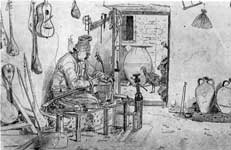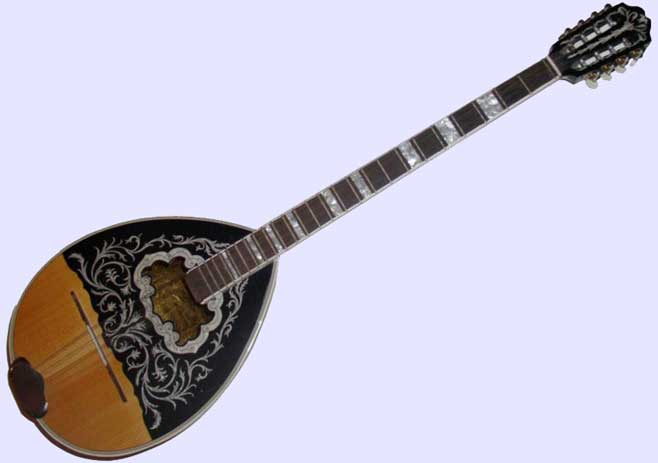.
The bouzouki (Greek: μπουζούκι pronounced [buˈzuki]; plural: μπουζούκια) is a musical instrument with Greek origin in the lute family. A mainstay of modern Greek music, the front of the body is flat and is usually heavily inlaid with mother-of-pearl. The instrument is played with a plectrum and has a sharp metallic sound, reminiscent of a mandolin but pitched lower. There are two main types of bouzouki. The three-course with three pairs of strings (known as courses) and the four-course having four pairs of strings.

Name
Bouzouki in Turkish means "broken (from Turkish: bozuk), not functioning, modified." Here it is used in order to specify the size of the instrument, because of its modified (not proper) nature. It might be concluded, therefore, that the bouzouki has been named after the jargon of the Greek tamboura named saz, by the Greeks living in Turkey. An alternative popular etymology maintains that the word bouzouki was used because different tunings are required for the instrument to play in different musical scales known as Dromoi in Greek or Maqam. ;"

Leonidas Gailas from Athens, bouzouki manufacturer, Martinus Rørbye
Around the turn of the 20th century in Athens and Piraeus musicians adapted the saz to their needs, replacing the tied frets with metal frets like those of mandolins and guitars , and in the process abandoning the 1/4 tone system for the Western equal-tempered tuned chromatic scale. By the 20's they had further changed the construction from solid carved saz bodies to mandolin-like bowl backs and had also added machine pegs, and settled on D A D as the tuning of the paired courses, the lowest pair including high octave double. The instrument was played with Greek guitars and a miniature version of itself tuned an octave higher. These instruments both are kind of transformation of ancient Greek Pandoura , the larger version called bouzouki and the diminutive baglamas.

History
Bouzouki exposed in the Museum of Greek Folk Musical Instruments in Athens
The origin of Bouzouki as a descendant of ancient Greek and eastern instruments, locates in ancient Greece,[1] where there had been an instrument known as the pandura or pandourion, also called the "trichordo" because it had three strings; it was the first fretted instrument known, forerunner of the various families of lutes worldwide.[2] The source of our knowledge about this instrument is the Mantineia marble (4th century BC), now exhibited at the National Archaeological Museum of Athens, depicting the mythical contest between Apollo and Marsyas, where a pandura is being played by a muse seated on a rock.[citation needed] The three-string, also known by the Hellenized name of Pandoura, refers primarily by lexicographers Pollux (2nd century AD) Hesychios, the Athenian and Nicomachus and Shown in clay figurines of 330-200 BC in the hands of women.
From Byzantine times it was called pandouras and then tambouras (Elizabeth Jeffreys, John Haldon, Robin Cormack, The Oxford Handbook of Byzantine Studies, Oxford University Press, 2008, p928. Cf. Nikos Maliaras, Byzantina mousika organa, EPN 1023, ISΒN 978-960-7554-44-4). On display in the National Historical Museum of Greece is the tambouras of a hero of the Greek revolution of 1821, General Makriyiannis.
the tambouras of Yannis Makriyannis exposed in the National Historical Museum, Athens
Other sizes have developed and include the Greek instrumental Tzouras, smaller in size than the standard.[3]
The early bouzoukia were mostly three-string (trichordo), with three courses (six strings in three pairs) and were tuned in different ways, as to the scale one wanted to play.[citation needed]
At the end of the 1950s, four-course (Tetrachordo) bouzoukia started to gain popularity. The four-course bouzouki was made popular by Manolis Chiotis who also used a tuning akin to standard guitar tuning, which made it easier for guitarists to play bouzouki, even as it angered purists. The first recording was made in 1958.
The Irish bouzouki, with four courses, a flatter back, and differently tuned from the Greek bouzouki, is a more recent development, dating back to the 1960s.The Irish bouzouki became popular around the same time, with four pairs of strings and a flatter back.[citation needed]
The Three-course Bouzouki (Trichordo)
Greek trichordo bouzouki
A close up of the headstock of a trichordo bouzouki. Two of these eight tuners are not strung.
This is the classical type of bouzouki that was the mainstay of most Rebetiko music. It has fixed frets and it has 6 strings in three pairs. In the lower-pitched (bass) course, the pair consists of a thick wound string and a thin string tuned an octave apart. The conventional modern tuning of the trichordo bouzouki is Dd-aa-dd. This tuning was called the "European tuning" by Markos Vamvakaris, who described several other tunings, or douzenia, in his autobiography. The illustrated bouzouki was made by Karolos Tsakirian of Athens, and is a replica of a trichordo bouzouki made by his grandfather for Markos Vamvakaris and became more famous from Manolis Chiotis. The absence of the heavy mother of pearl ornamentation often seen on modern bouzoukia is typical of bouzoukia of the period. It has tuners for eight strings, but has only six strings, the neck being too narrow for eight. The luthiers of the time often used sets of four tuners on trichordo instruments, as these were more easily available, since they were used on mandolins.[citation needed]
The Four-course Bouzouki (Tetrachordo)
This type of bouzouki has 8 metal strings which are arranged in 4 pairs, known as courses, typically tuned Cc Ff aa dd (i.e., one whole step below the four high strings of a guitar). In the two higher-pitched (treble) courses, the two strings of the pair are tuned to the same note. In the two lower-pitched (bass) courses, the pair consists of a thick wound string and a thin string tuned an octave apart. These 'octave strings' add to the fullness of the sound and are used in chords and bass drones (continuous low notes that are played throughout the music). The guitar-like tuning was introduced by composer and soloist Manolis Chiotis, who found it better suited to the kind of virtuoso playing he was famous for. Traditionalists shun the 4-course as they feel it alters the character of the instrument.[citation needed] Many musicians such as the aforementioned Chiotis and Giorgos Zampetas began using specially designed pickups to achieve a slightly thicker humbucker-like sound in the mid-1960s. These pickups are widely used by several Greek artists today and came in active and (usually) passive versions.[citation needed]
The Greek Baglamas
Main article: Baglamas
The Greek baglamas (Greek μπαγλαμάς) or baglamadaki (Greek μπαγλαμαδάκι), is very different from the Turkish bağlama. The treble bouzouki is pitched an octave higher (nominally D-A-D), with unison pairs on the four highest strings and an octave pair on the lower D. Musically, the baglamas is most often found supporting the bouzouki in the Piraeus style of rembetika.
Notable bouzouki players
Manolis Chiotis
Steve Earle
Giannis Tatasopoulos
Babis Tsertos
Vassilis Tsitsanis
Markos Vamvakaris
Nikos Vrachnas
Giorgos Zampetas
Dónal Lunny
See also
Greek music
Greek folk music
Laouto, another Greek lute
Stringed instrument tunings
Rebetiko
Laiko
Tzouras
Irish bouzouki
Related Instruments
Baglamas
Pandura
Mandolin
| Ancient Greece
Science, Technology , Medicine , Warfare, , Biographies , Life , Cities/Places/Maps , Arts , Literature , Philosophy ,Olympics, Mythology , History , Images Medieval Greece / Byzantine Empire Science, Technology, Arts, , Warfare , Literature, Biographies, Icons, History Modern Greece Cities, Islands, Regions, Fauna/Flora ,Biographies , History , Warfare, Science/Technology, Literature, Music , Arts , Film/Actors , Sport , Fashion --- |
Retrieved from "http://en.wikipedia.org/"
All text is available under the terms of the GNU Free Documentation License

